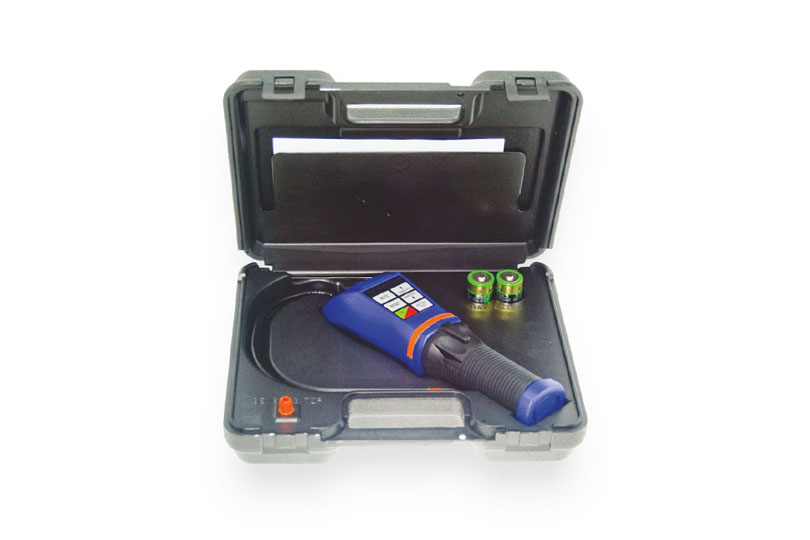SF6 Gas Detector
SF6 Gas Detector
Application Areas:For rapid detection of SF6 leaks
PGAS-32 SF6 leak detector is a device used to detect and measure leaks of sulfur hexafluoride (SF6) gas. SF6 is commonly used as an insulating and arc-quenching gas in high voltage electrical equipment, and leak detectors help to ensure that any leaks are detected and repaired quickly to avoid equipment damage and reduce the risk of environmental harm.
Commonly used as an insulating and arc-quenching gas in electrical equipment, such as switchgear and transformers.
PGAS-32 is portable Built-in air pump infrared principle SF6 leak detector.
Using our own production of diffusion SF6 sensor, stable performance, long service life.
Can quickly Alarm and Display the amount of SF6 leakage at the leak point
Product Features
- Digital display real-time readings of the SF6 gas concentration in PPM.
- Infrared sensor 10 years life
- Built-in air pump for high response speed
- Audible and Visible Alarms
- Built-in Rechargeable Battery
In What Scenarios Is It Necessary To Use A Sulfur Hexafluoride (SF6) Infrared Leak Detector?
The sulfur hexafluoride (SF6) infrared leak detector is mainly used to detect leaks in equipment containing SF₆ gas. Typical scenarios include:
- Core scenarios in the power industry: used for high-voltage equipment such as GIS combined electrical appliances and SF₆ circuit breakers to detect leaky parts such as flange interfaces and valves to prevent insulation failure or equipment failure caused by gas leakage; new equipment needs to be inspected and accepted after installation or overhaul to ensure sealing performance; periodic leak detection is carried out on operating equipment according to industry standards to evaluate the annual leakage rate (required to be ≤1%).
- Other industrial and safety scenarios: suitable for SF₆ insulated high-voltage cable terminals, laboratory gas devices, etc., to monitor sealing; when the oxygen concentration in a closed space (such as a distribution room) decreases, the equipment pressure alarm is abnormal, etc., the leak source can be quickly located to avoid suffocation or environmental pollution.
- Signals that trigger detection: When the equipment pressure gauge is abnormal, the density relay alarms, the abnormal discharge sound, or the ambient oxygen concentration decreases, the instrument is required to check the leak point. Its core function is to ensure the safe operation of the equipment, meet environmental protection requirements, and avoid serious accidents.
How To Choose A Reliable Sulfur Hexafluoride (SF6) Infrared Leak Detector?
- Performance parameters are the core: attention should be paid to sensitivity (such as 0.1ppm level), accuracy (within ±1.5%), response time (within seconds) and measurement range (adaptive scenarios such as 0-1000ppm) to ensure accurate detection.
- Brand and reputation: give priority to well-known brands with mature technology and reliable quality control, and refer to user feedback to evaluate stability and anti-interference ability.
- Functional design needs to meet the needs: such as one-button calibration, infrared remote control operation to improve efficiency, data storage and report generation for easy traceability, and protection level (such as IP33/IP65) selected according to the environment.
- After-sales service cannot be ignored: it is necessary to ensure that the supplier provides regular calibration, timely technical support and long warranty (≥1 year) to reduce operation and maintenance risks.
- Price and cost performance need to be balanced: avoid low-priced and low-quality products, choose basic or high-end models as needed, and verify performance through on-site trials. In short, combined with the scene requirements, comprehensive screening is carried out from performance, brand, function, and after-sales, taking into account both professionalism and economy.
How To Use The Sulfur Hexafluoride (SF6) Infrared Leak Detector Correctly?
1. Preparation before use: Understand the structure of the test object and the parts prone to leakage, and choose an environment without strong airflow, dust, and suitable temperature and humidity. Check the appearance and power of the instrument before turning on the machine, preheat and calibrate, and ensure the stability of the sensor.
2. Standard operation: Select the mode and set parameters according to the needs, maintain a suitable detection distance, scan the equipment at a uniform speed and multiple angles, and focus on the sealing interface and other parts. Identify the signal through imaging or numerical mode, record the leakage location, intensity and other data, and evaluate the leakage degree in combination with the standard.
3. Precautions and maintenance: Keep a safe distance when testing high-voltage equipment, ventilate the closed space first and detect the gas concentration. Avoid using the instrument in extreme environments, and do a good job of lens cleaning and shockproof. Clean the instrument in time on a daily basis, and remove the battery for long-term storage; it is recommended to be calibrated by a professional organization every year and keep the calibration records. Read the instructions carefully and receive training before operation to ensure accurate and safe detection.
Equipment Parameters
| Parameter Name | Standard Type | High-Sensitivity Type |
|---|---|---|
| Measurement Principle | Infrared Absorption Spectroscopy Principle | Infrared Absorption Spectroscopy Principle |
| Measurement Range | 0~1000ppm | 0~50ppm |
| Detector Sensitivity | 1×10⁻⁷ mL/s 1.0ppm 0.01g/y |
1×10⁻⁸ mL/s 0.1ppm 0.001g/y |
| Indication Error | <2%F.S | <2%F.S |
| Sampling Method | Pump Suction Type | Pump Suction Type |
| Operating Temperature | -10~+60℃ | -10~+60℃ |
| Response Time | 1~5s | 1~5s |
| Preheating Time | 100s | 100s |
| Probe Rod Length | 22cm | 22cm |
| Sensor Service Life | >10 years | >10 years |
| Power Supply | Internal Battery (2200mAh) | Internal Battery (2200mAh) |
| Weight | 0.7kg | 0.7kg |



Leave a Comment